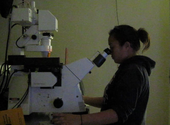Highlight
Researchers at UC Irvine have discovered a new micro and nanotechnology to effectively isolate, identify, recover, and then analyze individual adherent cells comprising a tumor
Achievement/Results
Researchers from the NSF-funded LifeChips Integrated Graduate Education Research Traineeship at the University of California, Irvine have developed a new micro and nanotechnology, the micropallet array (MPA). Dr. E.L. Nelson’s tumor lab and the biomedical engineering labs of Drs. Mark Bachman and G.P. Li worked together on this project. The LifeChips IGERT, a program that encourages collaborative research that transcends traditional disciplinary boundaries, brought these researchers from historically separate disciplines into convergence. In breast cancer patients, there is substantial variability in clinical behavior. Differences in cellular profiles, including the proportion of cancer stem cells, may explain the variability. A technology that can characterize rare cell subsets from a tumor is likely to aid in the design of personalized treatments. The micropallet array consists of transparent, polymer pedestals called micropallets that are designed to isolate single cells. A micropallet can be released and recovered on demand. The collected single cell can then be clonally expanded and cultured or studied at the molecular level. A laser is used at the interface of the micropallet and glass slide to ablate the material and release the single micropallet. The micropallets are magnetic to allow for a novel magnetic collection strategy. Single cells collected using the strategy can be clonally expanded and cultured for further downstream analysis or the gene expression can be immediately analyzed using single cell qRT-PCR. After developing the micropallet array, these researchers then developed a cell identification strategy to uniquely identify breast tumor cell subsets of interest. The cell identification strategy advanced the micropallet array technology platform by enabling the detection of cell types of interest based on their expression pattern of cell surface markers. The cell identification strategy involves multidisciplinary techniques from the fields of biomedical engineering, cell and molecular biology, and laser scanning confocal microscopy.
Address Goals
This discovery has advanced science by providing a way for researchers to study individual cell types from a tumor. Medical professionals will be able to provide personalized treatments for breast cancer patients using the micropallet array platform. The video associated with this discovery has been featured on the LifeChips website and in the 2012 IGERT online poster and video competition increasing scientific literacy through e-learning.












